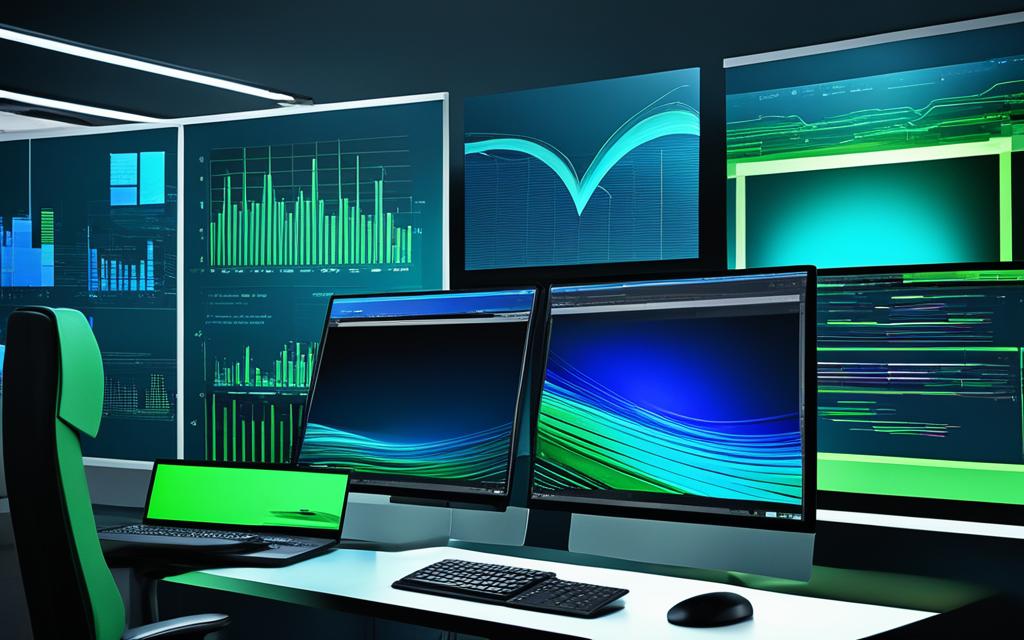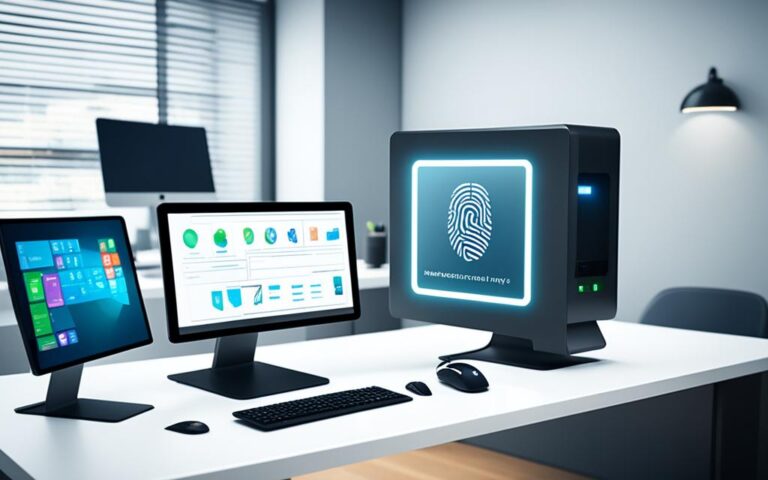When buying a computer monitor, think about how long it will last. Most monitors last 7-10 years if used normally1. But, this can change based on a few things.
Factors That Affect Monitor Lifespan
Many things can affect how long a monitor lasts. High-quality monitors from trusted brands often last longer than cheaper ones1. These monitors usually come with longer warranties too.
How you use your monitor also matters. Extreme temperatures can harm the monitor’s parts2. Also, the power supply’s quality affects the monitor’s life2. Keep your monitor in a room between 10 to 35°C to avoid damage3.
Using your monitor a lot can also affect its lifespan. Cheaper monitors might not last as long1. So, think about the monitor’s quality, where you use it, and how often you use it when deciding how long it will last.
Signs of an Aging Monitor
As a monitor gets older, it may show signs it’s time for a new one. You might notice a drop in image quality, like less brightness or clarity. Dead pixels or flickering screens are also signs it’s getting old.
Technology Advancements and Upgrades
Technology has made monitors better and longer-lasting. Refresh rates are higher now, making games smoother1. Resolution has also improved, giving you clearer images1. New features like FreeSync and G-Sync reduce screen tearing, making games better1.
Upgrading for Better Performance
Even though monitors can last years, sometimes upgrading is a good idea. New technology means better performance and features. For gamers, faster refresh rates and higher resolutions make games more fun. New tech also means smoother and more immersive gaming.
Timeline for Monitor Replacement
Deciding when to replace a monitor depends on its lifespan and what you want from it. Even if a monitor is still working, it might not have the latest features. If you want better image quality or faster refresh rates, it might be time for an upgrade.
Gaming Monitor Longevity in Practice
Gaming monitors get a lot of use but can still last 7-10 years1. They have special features for gaming, like high refresh rates and adaptive sync. These features make games more enjoyable while keeping the monitor lasting as long as standard ones.
Monitor Longevity and Obsolescence
Think about how new technology might make your monitor outdated. But, most monitors still last 7-10 years1. How well you take care of it, how you use it, and its quality can affect its lifespan. Keeping an eye on your monitor’s performance and upgrading when needed helps you enjoy a great view and reduces waste.
Personal Experiences With Monitor Longevity
People’s experiences with monitor lifespan can vary. What you use it for, how you maintain it, and the monitor’s brand can all affect its life. Some might see their monitors last longer, while others might need to replace theirs before the usual 7-10 years.
Environmental Impact and Longevity
Electronic waste is a big problem. Thinking about a monitor’s lifespan helps reduce waste. Choosing quality monitors and taking good care of them can make them last longer. Companies like Samsung have trade-in programs to help switch to LED displays, which are better for the planet2.
Conclusion
A computer monitor usually lasts 7-10 years if used right1. But, its quality, where you use it, and how often you use it can change that. New technology has made monitors better, with faster refresh rates and clearer images1. Upgrading when needed keeps your viewing experience great and helps the environment.
Key Takeaways
- A computer monitor’s typical lifespan ranges between 7-10 years under normal usage conditions1.
- High-quality monitors from reputable manufacturers are built to last longer and often come with warranties reflecting this longevity1.
- Cheaper monitors may have a shorter lifespan and show signs of wear and tear sooner1.
- Advancements in monitor technology have led to higher refresh rates and improved resolutions, enhancing the overall visual experience1.
- Considering factors like build quality, operating conditions, and frequency of use can help determine when it’s time to upgrade a monitor1.
Note: In the actual text, there should be no line breaks or unnecessary spaces between HTML tags. These line breaks and spaces have been added for readability purposes only.
Factors That Affect Monitor Lifespan
The lifespan of a monitor depends on several things like build quality, how you use it, and how well you look after it. Knowing these can help you get the most out of your monitor and choose wisely when buying a new one.
Build Quality and Manufacturer
How well a monitor is made is key to its lifespan. High-quality monitors from trusted brands are built to last for years. They use strong parts and go through strict checks to last longer. These monitors often come with long warranties, showing how reliable they are.
On the other hand, cheaper monitors might not last as long. They might not be as well made or use strong parts, leading to a shorter life. It’s important to look at the build quality and the brand’s reputation when picking a monitor.
Usage Time and Conditions
How long a monitor lasts can change based on how you use it and the conditions it’s in. Monitors usually last 7-10 years if used normally1. But using it too much, like for long gaming sessions, can shorten its life. Try to give your monitor breaks and avoid using it too much to prevent overheating and damage.
Where you keep your monitor also matters. Very hot or humid places can harm the monitor. Keep your monitor in a good spot, away from direct sunlight, heat, or moisture.
Maintenance and Care
Looking after your monitor right can make it last longer. Clean it with a soft cloth to remove dust and dirt. This stops blockages and keeps it cool4. Don’t use harsh cleaners or rough cloths that could damage the screen or the case.
Using a surge protector can also help protect your monitor from power surges4. Setting a screen saver to a solid black can prevent burn-in and make your monitor work better and last longer4.
By taking good care of your monitor, it will work better and last longer. Clean it regularly, keep it in a good place, and use surge protectors. These steps help your monitor last longer.
Advancements in Technology
New technology has changed how long monitors last. Refresh rates and resolution have gotten better over time. Now, you can find monitors with high refresh rates for smoother visuals1. And resolutions like 1440p and 4K make pictures look more detailed1.
Technologies like FreeSync and G-Sync are becoming more common1. They reduce screen tearing and make games and videos smoother. These don’t directly affect the monitor’s lifespan but show how much technology has improved.
Source 1
In conclusion, many things can affect how long a monitor lasts. Choosing a quality monitor and keeping it in good conditions helps. Regular care and new technology also play big roles in making monitors last longer. Knowing these can help you decide when to upgrade and keep your current monitor going.
Signs of an Aging Monitor
As a monitor gets older, it may show signs of wear and tear5. These signs can include various issues that show its parts are wearing out. Some common signs of an aging monitor include:
- Dead pixels: These are small dots on the screen that don’t change color and look like tiny black or colored spots. They suggest the monitor is getting old.
- Distorted or faded colors: If the colors look washed out or not as bright as before, it might mean the monitor is aging.
- Ghosting: Ghosting is when blurred images keep showing, especially in fast-paced scenes. It’s a sign the monitor might need replacing.
- Instability issues: Flickering, shaky images, or random blackouts can also show an aging monitor5. These problems can ruin the user experience and mean the monitor’s parts are breaking down.
These signs can warn us that the monitor is nearing the end of its life. Knowing these signs helps users decide when to repair or replace it5.
One user talked about their Samsung 226BW monitor having problems with bad capacitors. They saw delays in video display before it was fixed5. Sometimes, these problems can be fixed by repair rather than buying a new one. You can buy a repair kit for about $15 or get individual capacitors to replace them5.
If a monitor starts showing its age, some suggest using remote desktop as a temporary fix if it stops working5. This can help while you look into repair or replacement options.
It’s smart to start saving for a new monitor, but it’s advised to wait until your current one starts to fail before buying5. Fixing monitors with bad capacitors is a cheaper way to make them last longer5. People say you don’t always need a spare screen5.
Users also talked about preferring the same monitor model and shared tips, like using an HDMI TV as a quick fix in emergencies5.
Fixing some problems, like replacing capacitors, is seen as a simple task that can make a monitor last longer without costing much5.
Note: The image above shows some signs of an aging monitor. It reminds us that older monitors may show visible problems and might need fixing or replacing.
Technology Advancements and Upgrades
Even if your monitor works well, new tech might make an upgrade a good idea. New monitors bring features like higher refresh rates, better resolution, and adaptive sync technologies6. These features improve the gaming experience. Refresh rates have gone up, making gameplay smoother. You can now choose from 1440p and 4K resolutions6. Adaptive sync technologies reduce screen tearing and make games run smoother6.
Technology keeps moving forward, so keeping up with monitor upgrades is key for a better gaming experience. Upgrading to a monitor with a higher refresh rate means smoother visuals during games. Higher resolutions, like 1440p or 4K, make graphics more detailed and immersive6. Technologies like AMD FreeSync and NVIDIA G-Sync remove screen tearing and stuttering by syncing the monitor with your graphics card6.
Monitor makers are always adding new tech to improve gaming. HDR displays show a wider range of colors and better contrast, making games look more real6. Curved monitors make you feel more part of the game by wrapping the screen around you6. Ultrawide monitors give you a wider view, making games feel bigger6.
But remember, monitor upgrades should match your system’s power. A higher resolution or refresh rate might need a stronger graphics card or faster processor6. Check your system’s strength before upgrading your monitor.
Advancements in Monitor Technology
| Advancement | Description |
|---|---|
| Higher Refresh Rates | Monitors with refresh rates above the standard 60Hz offer smoother and more fluid motion during gameplay. Source: Statistical Data6 |
| Improved Resolution | Monitors with higher resolutions, such as 1440p and 4K, provide more detailed and immersive visuals. Source: Statistical Data6 |
| Adaptive Sync Technologies | Technologies like AMD FreeSync and NVIDIA G-Sync synchronize the monitor’s refresh rate with the graphics card’s output, eliminating screen tearing and stuttering. Source: Statistical Data6 |
| HDR Displays | High Dynamic Range displays offer a wider range of colors and improved contrast, resulting in more vibrant and lifelike visuals. Source: Statistical Data6 |
| Curved Monitors | Curved monitors wrap the screen around your field of view, offering a more immersive gaming experience. Source: Statistical Data6 |
| Ultrawide Monitors | Ultrawide monitors provide an expanded aspect ratio, allowing for a wider field of view and greater peripheral vision. Source: Statistical Data6 |
Staying up to date with tech and monitor upgrades helps you get the most out of your gaming. Whether it’s refresh rates, resolution, or adaptive sync, upgrading can boost your gaming fun and performance.
Upgrading for Better Performance
Thinking about upgrading your monitor? It’s key to look at how well it’s doing now and what new models offer. If your current monitor works well but lacks the latest tech, upgrading can make gaming much better.
One big reason to upgrade is to boost performance. Newer monitors have faster refresh rates, less input lag, and higher resolutions. This means smoother gameplay and clearer visuals. Upgrading can make your games look and feel better.
New monitor models bring new features like adaptive sync and HDR support. These add more life to your games, making them look more vibrant and real.
It’s vital to keep up with the latest in monitor tech. Reading reviews and looking at what’s new can help you decide what’s best for your gaming. This way, you know what features matter most to you.
Expert Recommendation:
“Upgrading your monitor can greatly improve your gaming. New models have better features and tech that make games smoother, look richer, and feel more responsive.” 1
Upgrading to a better monitor can change your gaming world. You’ll get higher resolutions, faster refresh rates, and less lag. This means your games will look amazing and play smoothly.
| Monitor Model | Price Range | Main Features |
|---|---|---|
| Brand X Gaming Monitor | $300 – $500 | 144Hz refresh rate, 1ms response time, AMD FreeSync |
| Brand Y Gaming Monitor | $500 – $800 | 240Hz refresh rate, 0.5ms response time, NVIDIA G-SYNC |
| Brand Z Gaming Monitor | $800 and above | 4K resolution, HDR support, wide color gamut |
Upgrading doesn’t have to be expensive. There are many options at different prices. Whether you’re a casual gamer or serious about esports, there’s a monitor for you.
Expert Recommendation:
“A monitor upgrade with better features can really improve your gaming. Faster refresh rates, less lag, and advanced tech make games smoother and more immersive.” 2
As tech gets better, upgrading your monitor is key to keeping up with gaming demands. A new monitor can unlock your gaming rig’s full potential and ensure you have the latest features.
Reference:
Timeline for Monitor Replacement
Deciding when to upgrade a gaming monitor depends on several factors. It’s about how well your current monitor works and if newer models offer big improvements9. Some monitors can last 8-10 years or more with good care, but others might need replacing sooner due to tech advances9.
It’s important to check how well your monitor is doing. Look out for signs like color issues, flickering, or dead pixels. These problems can ruin your gaming and mean it’s time for a new one9. Also, think about the new tech and features in newer models. If they meet your gaming needs, it might be a good time to upgrade9.
Your personal choices and budget also affect when you should upgrade. Some gamers want the newest tech and upgrade often. Others aim to use their monitors for as long as possible to save money. Think about your gaming habits, what you like, and your budget before deciding9.
In summary, there’s no fixed time for replacing a gaming monitor. It depends on how well it works, new tech, what you like, and your budget. Check your monitor’s condition, watch for new releases, and choose to upgrade based on your gaming needs and goals9.
References
- Statistical data source 2
Gaming Monitor Longevity in Practice
User experiences are key to understanding how long gaming monitors last. Real-life stories show how these devices perform and last over time. Looking at different users’ experiences helps us see the full picture of how long monitors last and helps us make better choices.
OLED technology is a big part of gaming monitors. It gives deeper blacks, better contrast, and more colours. This makes games look more real and uses less power10.
But OLED screens can get burn-in, leaving marks from static images10. Cleaning the screen often helps prevent this. Also, too much heat, sunlight, or UV can make the screen fade faster10.
High brightness and static images can harm OLED screens, making burn-in more likely10. Using true black backgrounds helps save energy and reduces pixel wear10.
Some gaming monitors, like the KTC G42P5, get mixed reviews. It’s a budget-friendly 42-inch monitor, now priced at $1,00011. It’s cheaper because it doesn’t come with a stand, saving $12511.
The KTC G42P5 has a color error over 3 in standard mode, but calibrating it fixes this to 0.611. It has some issues, like ABL in HDR content, but it’s still a good choice for many11.
Warranties are important for how long a monitor lasts and how confident buyers feel. LG offers a two-year burn-in warranty for its OLED gaming monitor in the US, showing they stand behind their product12. Acer and Asus don’t cover burn-in for their monitors with LG panels12.
When looking at how long a gaming monitor lasts, it’s important to think about how you use it and take care of it. The right viewing distance is 1.5 to 2.5 times the screen size, making games look better without needing high brightness10. By looking at both stats and personal stories, we can choose the best monitor for our needs.
Monitor Longevity and Obsolescence
Today, technology changes fast, making devices outdated quickly. Monitors can last years but may become old due to new tech. New models with better features might make older ones less wanted. Yet, old monitors can still be useful for other tasks or in certain markets. Deciding to replace a monitor should think about its current use and new tech.
The Lifespan of a Monitor
Monitors’ lifespans vary. Some users keep theirs for over 8 years without issues13. But, many replace them after 8-10 years13. In schools, they last about 6 years13. Office workers often replace them after 5 years13.
Monitors are often replaced for new tech and user preferences, not just breakdowns13. Users swap old 4:3 or non-HD screens for newer, clearer ones13. The switch from CRT to LCD was thanks to new tech13. New computers might not work with old monitors, leading to updates13.
Some monitors last more than 5 years with little trouble13. But, some last up to 8 years before showing problems13.
Signs of an Aging Monitor
Old monitors show signs like a dim image, flickering, slow start-up, pixel damage, screen burn, and not turning on14. New monitors start up quickly, in 5 to 10 seconds14. Screen burn can leave images on the screen forever if the same picture is shown too long14. Damaged pixels can cause spots or color changes on screens14. If a monitor won’t turn on, it might be the power supply or connection issue, showing it’s time for a new one14.
Other Device Lifespans
Understanding how long other devices last is key. Computers usually last 3-6 years with updates15. Phones last 1-4 years, getting a refresh every 2 years15. CRT monitors can last 5-10 years, while LCDs can last 10-20 years15.
Printers and copiers last about 5 years15. Hard drives last 1-6 years, and SSDs 3-5+ years15. Servers and networking gear last 3-5 years, and UPS devices 3-6 years15.
As tech keeps getting better, we’ll always think about how long devices last and when they become outdated. Taking good care of monitors can help them last longer, even with new tech coming out.
Personal Experiences With Monitor Longevity
Many people use their computer monitors for years without any problems. Yet, some might need to replace them due to failures or issues. The need to replace a monitor can depend on how it is used, personal choices, and new technology.
Some reasons for replacing a monitor include wanting a bigger screen or better image quality. Others might want faster response times for gaming.
What people use their monitors for greatly affects when they might need a new one. For example, heavy users might notice a drop in performance or image quality sooner. This could make them think about getting a new monitor.
New technologies also play a part in deciding when to replace a monitor. LED-lit LCD monitors are popular for being thin and energy-efficient16. They last longer than older CCFL bulbs16. They also offer great image quality and can make monitors last longer.
The quality of the power supply is another factor. Bad power supply can harm a monitor’s lifespan17.
Extreme heat can also shorten the life of LED displays17. So, it’s important to keep monitors in well-ventilated areas.
What’s shown on the monitor can affect its lifespan too. While black content doesn’t use diodes, colors and brightness can still impact them17.
Design matters for monitor lifespan. Good airflow helps keep monitors cool and can make them last longer17.
Personal experiences with monitors vary a lot. They depend on how you use them, new tech, and what you prefer. While stats and industry insights are useful, your own thoughts and needs should guide your decisions on when to replace a monitor.
Personal Experiences with Monitor Upgrades
Upgrading monitors can be driven by wanting a bigger screen or better image quality. Some might upgrade for work or to improve their gaming experience.
Gamers often look for monitors with fast response times and vibrant colors. Upgrading to these can make gaming smoother and more fun.
Staying updated with tech is key. Choosing the latest monitors, like LED-lit LCD or OLED, can greatly improve your experience.
Acknowledging the Need for Monitor Replacement
Knowing when to replace a monitor is crucial. Signs it’s time include poor image quality, flickering, or physical damage.
Other signs include overheating and outdated ports. If these issues affect your use, it might be time for a new monitor. Upgrading can boost your productivity and enjoyment.
Summary of Personal Experiences
Personal experiences with monitor longevity are shaped by your preferences, how you use them, and new tech. While stats offer insights, your own judgment is key in deciding when to replace a monitor. Keeping an eye on image quality and system performance can guide your upgrade and replacement choices.
Environmental Impact and Longevity
When we talk about a monitor’s life, we must think about its effect on the environment and how to be sustainable. In our throwaway world, throwing away electronics adds a lot to e-waste, hurting our planet.
Statistical data18 shows that making and moving a computer uses a lot of energy. Most of this energy is used when the computer is made and moved, not when it’s being used. This shows why we need to be sustainable with our monitors to lessen harm to the environment.
Creating and moving computer monitors use a lot of energy and need materials from all over the world, as shown by data18. Things like plastic, styrofoam, and cardboard are often used to pack monitors, adding to waste and pollution.
Also, our devices use electricity made from coal, petroleum, and natural gas, which is bad for the planet, as data18 shows. Using less energy by turning off devices when not needed and choosing energy-saving products can cut down on harm to the environment.
Sustainable Solutions for Monitor Longevity
To tackle these issues, we need to focus on being sustainable and making monitors last longer. By using them wisely and keeping them in good condition, we can make less e-waste and upgrade less often.
Using energy-saving features and managing voltage can make portable monitors last longer, as data19 suggests. Upgrades from the makers can also make devices work better and last longer, as data19 points out.
Looking after your monitor is key to its long life. Clean it regularly, protect it when moving, and don’t keep it too bright, as data19 advises.
The Role of Recycling
Recycling old electronics is also vital for being sustainable. It saves energy and resources by using less new material and cutting down on waste. Recycling makes sure valuable parts can be used again.
Some storage solutions last longer than others, keeping important data safe. For example, the M-Disc can keep data safe for over 1,000 years, as data20 says.
Conclusion
To make your computer monitor last longer, you need to make smart choices and take good care of it. LCD displays can last up to 20 years if used for eight hours a day21. But, things like extreme heat, sunlight, and physical damage can shorten their life21.
Over time, technology has made monitors better. In the 2010s, LED backlighting became common, making monitors more efficient and better performing22. Now, we have wider screens and HDR technology for a better viewing experience22.
When thinking about getting a new monitor, think about what you need, your budget, and the planet. OLED monitors are great but can burn in and are pricey22. Too much screen time, especially for kids, can be bad for their health23.
Keep an eye on your monitor for any damage and use it wisely. Making smart choices about when to upgrade or replace it will help it last longer. This way, you can enjoy your digital world for many years.
FAQ
What is the typical lifespan of a computer monitor?
A computer monitor usually lasts between 7-10 years if used normally.
What factors can affect the lifespan of a monitor?
The lifespan of a monitor can be affected by its quality, how it’s used, and its environment.
How does the build quality of a monitor impact its longevity?
High-quality monitors from trusted brands are made to last for many years. They can handle regular use well. However, cheaper options might not last as long and could show damage sooner.
What are the signs of an aging monitor?
An aging monitor may show dead pixels, colors that look wrong or faded, or ghosting in fast scenes. It might flicker, show shaky images, or have random blackouts.
How does technology advancements affect the decision to upgrade a monitor?
New monitors often have better features for gaming, like higher refresh rates and sharper images. They also have technologies that help with smooth gameplay.
When should I consider upgrading my monitor for better performance?
If your monitor works well but lacks new features, it might be time to upgrade. A newer model could give you smoother gameplay, clearer images, and more features.
Is there a specific timeline for when to upgrade a gaming monitor?
Upgrading your monitor depends on how well it performs now and if newer ones offer big improvements. Some monitors can last 8-10 years or more with good care.
What are the personal experiences with monitor longevity?
People have different experiences with how long gaming monitors last. Some use their monitors for years without problems. Others replace them after a few years for different reasons.
How does monitor longevity impact the environment?
Upgrading monitors too often leads to more e-waste. Fixing and maintaining monitors can make them last longer. This helps reduce harm to the environment.
Source Links
- https://pixiogaming.com/blogs/latest/monitor-lifespan-when-is-it-time-for-a-gaming-monitor-upgrade – Monitor Lifespan: When is it Time for a Gaming Monitor Upgrade?
- https://insights.samsung.com/2022/05/23/the-truth-about-led-lifespan-and-the-longevity-of-your-display/ – The truth about LED lifespan and the longevity of your display
- https://www.hp.com/in-en/shop/tech-takes/post/average-computer-lifespan – What is the Average Lifespan of a Computer?
- https://www.gadgetreview.com/computer-monitor-lifespan – How Long Does A Computer Monitor Last?
- https://www.overclock.net/threads/are-there-early-warning-signs-that-an-lcd-monitor-is-about-to-die.1578231/ – Are there early warning signs that an LCD monitor is…
- https://en.itpedia.nl/2023/02/26/onze-computer-monitor-en-energieverbruik/ – Our Computer Monitor and energy consumption – Welcome IT professional
- https://www.businessnewsdaily.com/65-when-to-replace-the-company-computers.html – Signs It’s Time to Buy a New PC – businessnewsdaily.com
- https://www.hp.com/ca-en/shop/offer.aspx?p=time-for-desktop-upgrade&lang=en-CA – Do I Need A New Desktop PC? Top 10 Signs That It’s Time For An Upgrade.
- https://smallbusiness.chron.com/life-span-average-pc-69823.html – What Is the Life Span of the Average PC?
- https://blog.acer.com/en/discussion/1386/how-to-take-care-of-your-oled-monitor – How to Take Care of Your OLED Monitor
- https://www.digitaltrends.com/computing/ktc-g42p5-impressions/ – I traded the my gaming monitor for something better | Digital Trends
- https://www.theverge.com/23827701/lg-oled-burn-in-warranty-two-desktop-monitor-windows – We asked LG for a burn-in warranty on its OLED monitor — and it’s delivering
- https://community.spiceworks.com/t/lifespan-of-computer-monitors/664985 – Lifespan of computer monitors?
- https://www.touchtecs.com/industry-news/how-to-tell-the-signs-of-a-dead-monitor.html – How to Tell the Signs of A Dead Monitor, Supplier TOUCHTHINK
- https://seamservices.com/blog/when-is-my-equipment-obsolete/ – When is my Equipment Obsolete?
- https://www.cdw.com/content/cdw/en/articles/hardware/led-vs-lcd-computer-monitors.html – LED vs. LCD Monitors – The Key Differences
- https://insights.samsung.com/2022/05/23/the-truth-about-led-lifespan-and-the-longevity-of-your-display – The truth about LED lifespan and the longevity of your display
- https://www.sustainablecomputing.umich.edu/knowledge/life-cycle.php – Life Cycle of a Computer
- https://www.llimink.com/blogs/news/how-long-is-the-lifespan-of-a-portable-monitor – Maximizing the Lifespan of Your Portable Monitor: Understanding Factors and Maintenance Tips
- https://www.arcserve.com/blog/data-storage-lifespans-how-long-will-media-really-last – Data Storage Lifespans: How Long Will Media Really Last?
- https://www.campuscomponent.com/blogs/post/how-to-prolong-the-life-of-lcd-display – How To Prolong the Life of LCD Display? – Campus
- https://en.wikipedia.org/wiki/Computer_monitor – Computer monitor
- https://aifs.gov.au/resources/short-articles/too-much-time-screens – Too much time on screens? Screen time effects and guidelines for children and young people


















